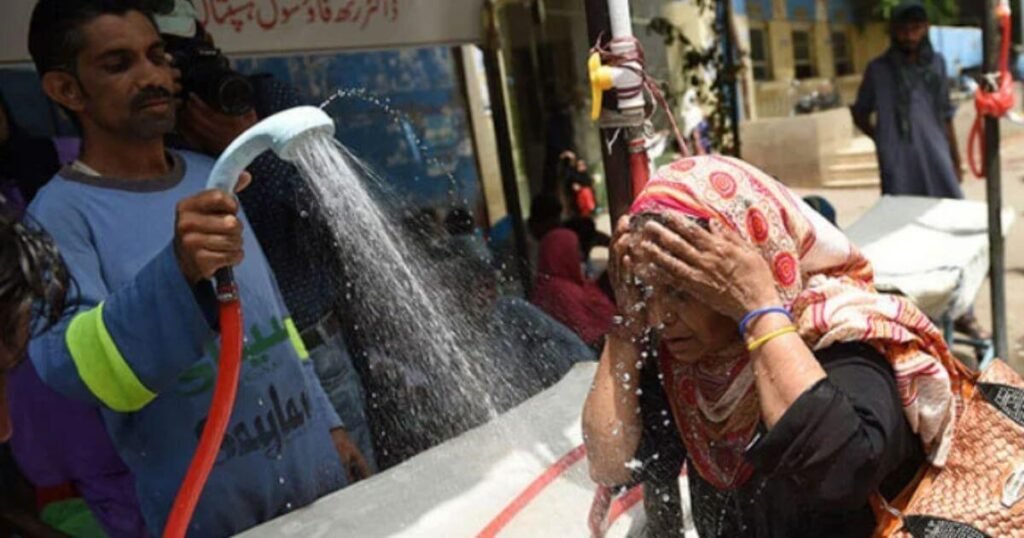Standing outside feels like stepping into an oven as Karachi Temperature Hits 40°C this Tuesday. Coastal areas feel even hotter with perceived temperatures rising to 45°C despite the city’s proximity to water. The lack of sea breeze during daytime hours transforms familiar streets into furnaces. Relative humidity dropped from 78 percent in the morning to 28pc by evening, yet discomfort intensifies. Winds from the west currently blow at a speed of 17 kilometres per hour.
The humidity level stands at 74%, contributing to these sweltering conditions across residential zones. Maximum temperature recorded at Mauripur and Gulistan-i-Jauhar hit 40°C, while the city average reached 39.1°C. Met department data showed temperature patterns worsening through Wednesday and Friday. Strong sunshine with minimal wind activity increases suffering for residents. Expected range between 35°C and 37°C seems optimistic given current trends.
Temperature and Weather Conditions
| 11 AM | 94° | Mostly sunny |
| 12 PM | 98° | Mostly sunny |
| 1 PM | 93° | Mostly cloudy w/ t-storms |
| 2 PM | 90° | Mostly cloudy w/ t-storms |
| 3 PM | 88° | Intermittent clouds |
| 4 PM | 91° | Mostly cloudy |
| 5 PM | 93° | Cloudy |
| 6 PM | 90° | Intermittent clouds |
Humidity trapped the city as the mercury began its relentless climb toward 40°C on Tuesday. The PMD (Pakistan Meteorological Department) confirmed temperatures soared across multiple parts, driven by a well-marked low pressure area prevailing over the region. This scorching heatwave left the port city bracing for another surge as today marks the peak. Karachi endures intense heat while the country watches this weather influence unfold. The expected 40 degrees Celsius milestone represents more than numbers—it signals genuine distress for millions reeling from unrelenting warmth.
Vulnerable groups including children, the elders, and patients with heart or kidney conditions face elevated risk during these extreme spells. Health experts warned repeatedly about the dangers lurking within such oppressive atmospheric pressure. Those suffering from pre-existing ailments find their symptoms magnified when temperature and humidity combine forces relentlessly.
Health Concerns and Medical Advice
- High risk of heatstroke and dehydration.
- Drink plenty of water and fluids to stay hydrated.
- Avoid direct sunlight between 11 AM – 4 PM.
- Wear light, breathable clothing and use hats/shades.
- Stay in cool, ventilated places whenever possible.
- Elders, children, and heart patients need extra care.
- Seek medical help if dizziness, nausea, or fainting occurs.
Hypertension and cardiovascular complications surge during extreme heat waves, requiring immediate medical attention for vulnerable populations. Elder citizens face heightened risk of heat stroke when temperatures soar beyond tolerance thresholds. Dehydration symptoms often appear subtly—drink water consistently rather than waiting for thirst signals. Avoid outdoor activities during peak afternoon hours to minimize exposure to dangerous mercury levels.
Health professionals recommend monitoring body temperature regularly and seeking shade whenever possible throughout daytime periods. Stay indoors with adequate ventilation or cooling systems to prevent heat-related medical emergencies effectively. Light-colored clothing helps reflect sunlight while loose fabrics allow better air circulation around skin. Symptoms like dizziness or nausea demand immediate response—never ignore early warning signs of heat exhaustion.
Weather System and Rainfall Forecast

Office workers remain cautious as temperatures keep hovering near 41°C with meteorological systems likely to bring scattered precipitation patterns. Atmospheric pressure zones shift unpredictably across coastal regions during intense heat waves.
Western disturbances interact with monsoonal moisture creating temporary relief possibilities. Forecast models suggest brief cooling episodes may interrupt sustained thermal stress periods.
Safety Measures and Precautions
- Limit outdoor activities in peak hours.
- Keep ORS or electrolytes handy to prevent dehydration.
- Use sunscreen to protect skin from burns.
- Never leave children or pets in parked cars.
- Take frequent breaks if working outdoors.
- Monitor weather updates and follow advisories.
- Check on neighbors and vulnerable people regularly.
Outdoor workers must drink four litres of water daily to counter excessive sweating during peak afternoon hours. Medical experts urge people to wear light-coloured, loose-fitting clothing and use a cap, scarf, or umbrella when venturing outside. Citizens are advised to take necessary precautions against heat-related illnesses by avoiding outdoor activities in direct sunlight. Indoor workers should aim for 13 to 15 glasses daily to ensure proper hydration.
Drinking plenty of fluids at regular intervals, including lemon or yoghurt-based drinks like lassi, helps stay cool and prevents dehydration. Professionals recommend avoiding heavy, spicy, and fried foods while opting for light, fresh meals to reduce internal body heat. Protect yourself by staying hydrated and monitoring any unusual symptoms that might indicate heat exhaustion.
Frequently Asked Questions (FAQs)
What is the hottest temperature ever recorded in Karachi?
The highest temperature ever recorded in Karachi was 48°C on May 22, 1981, which remains the city’s all-time record.
When was the 40 degree heat wave?
Karachi experienced a 40°C heat wave in late September 2025, with several areas reporting extreme humidity and discomfort.
Is summer 2025 going to be hotter than 2024?
Early forecasts suggest summer 2025 is expected to be hotter than 2024, with prolonged heat spells due to climate change.
How many people died in the heat wave in Karachi?
In past severe heat waves, such as 2015, over 1,200 people lost their lives, though recent 2025 waves have not reached that level.
What country has the worst heat?
Kuwait, Iran, and Iraq often record some of the world’s highest temperatures, frequently crossing 50°C in summer months.
What happens in 40 degree heat?
At 40°C, people face risks of heatstroke, dehydration, and exhaustion; vulnerable groups like elders and children are most affected.
Read Also:
Petrol and Diesel Price Increased Again, Third Hike This Month
Baaghi 4 Day 7 Box Office Collection Updates
Conclusion
Hot weather in Karachi demands awareness as hospitals see surge of patients. City residents work through high temperatures while conditions remain extremely challenging throughout the week. Emergency rooms handle cases of electrolyte imbalance and kidney stones daily. Urination reduced, fluids depleted, bodies weakened under relentless heat stress daily.
Dr Imran Sarwar from Civil Hospital notes many arrive in state of severe dehydration. Owais Hyder, Meteorological analyst, forecast no relief as pressure system moves west. Humidity levels remaining high while Thatta, Hyderabad, and surrounding districts brace for similar conditions. Blood pressure complications and heart disease worsened by sustained exposure outdoors.
Dua Mahfooz is an experienced journalist and financial analyst for Pakistan Coverage, specializing in celebrity net worth analysis, entertainment industry trends, and breaking news. With expertise in wealth assessment and market research, she provides accurate financial insights on public figures alongside comprehensive coverage of political, economic, and social developments. Her commitment to thorough research and fact-checking ensures reliable, well-sourced content across diverse topics.




